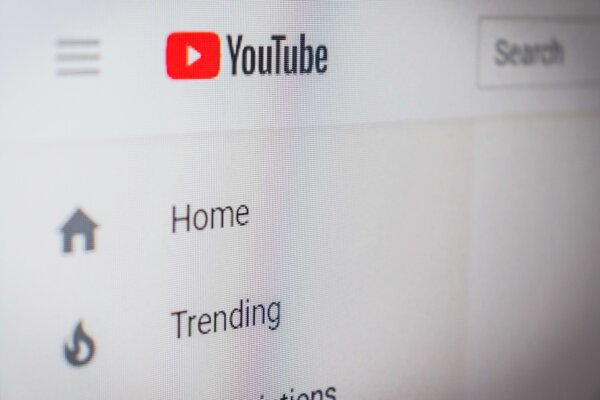
103 Insightful Facts to Inspire Your Video Marketing Strategy
These statistics highlight why your brand can't ignore the importance of having a robust video marketing strategy.
Back in 2009 (an eon ago by digital marketing standards), internet prophets were excited over a trend they said would soon take over the internet.
The irresistible forward march of technology made it possible for average viewers on average connections and devices to choose video over other forms of content… and the masses were taking the bait like hatchery trout on opening day.
The statistics were astounding.
But that was almost a decade ago. What’s the status of video marketing now? Have the predictions panned out? Is video the powerhouse the pundits thought it would be?
What’s the status of video marketing now? Have the predictions panned out? Share on XWe’ve gone back through the annals of internet history to pull up the old data, and we’ve compared it to the current data. Not only are the comparisons fascinating, but they are useful.
Armed with the information we’ve collected here, ecommerce and lead-generation website marketing managers will be able to take a closer look at their current video marketing strategy. They can find the gaps, shore up their tactics to increase conversions, augment brand-building efforts, breathe fresh life into search engine optimization (SEO) efforts, increase visitor engagement with the marketing mix, and provide better customer service.
We know those are huge claims for one report, we’ve delivered on those promises and more. All you need to do is keep reading, implement the take-aways, and then share this resource with your team.
Hurry, though, before your competitors beat you to the punch.
Let’s go.
Your Online Video Marketing Strategy Can Help Increase Conversions and Drive Sales
The bottom line results for any marketing campaign must always point to the effect on sales revenue. Not only is video marketing a powerful means of getting more conversions and pushing sales in the right direction, it lends itself to quantifiable measurements and accurate attribution. It’s not difficult to prove the value of video marketing online.
Here are some of the statistics we’ve found highlighting the results digital marketers are realizing from their efforts:
- Online shoppers would rather watch a video about a product than read about the product by a four-to-one margin (Animoto).
- Watching a brand video provided enough incentive to for 84 percent of online consumers to make the purchase (Hubspot).
- Ecommerce businesses that use videos realize an average 34 percent more online conversions than those who don’t use video (Vidyard-Aberdeen).
- Videos help with multiple KPI’s – sales revenue, website visits per month, customer support demand, organic search results, time on site, etc. (Hubspot).
- A Stacks and Stacks study showed that visitors who watched videos on a product page were 144 percent more likely to add the product to their shopping cart (Digital Commerce 360).
- Viewing a product video makes it 85 percent more likely the visitor will purchase the product viewed (Yum Yum Videos).
- Merchants experienced conversion rate increases ranging from 12 percent to 115 percent after adding video to their ecommerce websites (Practical Ecommerce).
- Shoeline.com conversions grew by 44 percent after they implemented product videos on their website (Internet Retailer).
- A Zappos test revealed product sales increases of 6 percent to 30 percent after videos were added to pages (ReelSEO).
- Conversion increases of 30 percent and average sales value growth of 13 percent can be expected after videos are added on a retail ecommerce website (L2 Specialty Retail Report).
- Video was cited as being a “significant influence” in the purchasing decision by 20 percent of all males surveyed in one study looking at buying habits for watches and jewelry (Ad-ology).
- Consumers will spend $3.45 in the store for every dollar spent online when retailers maintain both a local and an ecommerce presence (eMarketer).
- An ice.com study saw conversions increase by 400 percent for visitors who viewed videos versus those who did not. Video was also credited for lowering the product return rate by 25 percent (Internet Retailer).
- An onlineshoes.com study found that shoppers who watch a video are 45 percent more likely to make a purchase than those who do not. The site reported a 359 percent year-over-year uptick in video views, and tracking showed that product pages (across the board) show a higher conversion rate when video was added to the content mix. (Internet Retailer).
- Reckitt Benckiser saw in-store sales grow by six percent after adding video to their online marketing mix (Reckitt Benckiser/Nielsen).
- One study found that using the word “video” in the subject line of an email pushed open rates up by as much as 13 percent (Experian).
- Email click-through rates (CTR) can grow by up to 96 percent when video is included in the content. The number of marketers saying they plan to use video in email campaigns rose 500 percent from 2009 to 2010 (Implix 2010 Email Marketing Trends Survey).
- A 2010 study found that email click-through rates improved by up to 300 percent when video was used in the content (Forrester).
- Including video in the content was shown to boost lead conversions by 51 percent (Blue Sky Factory).
- A study of Swimwear Boutique customers found that more than 90 percent of respondents said video helped them make purchasing decisions (Internet Retailer).
- The majority of digital marketers agree video value for marketing is clearly demonstrated through statistics like conversion rate, cart abandonment rate, site visitor rate, and view rate (Practical Ecommerce).
- Almost half of all online shoppers say they look for videos about a product or service they want to purchase BEFORE going to the brick and mortar location (Google).
- Of 2,000 digital marketers queried, the consensus is that video and other multimedia content are more effective for ecommerce than any other method of marketing (Adobe).
- PetsUnited.com realized a 50 percent jump in average order value when shoppers viewed a video before making a purchase (eMarketer).
- Viewing a video makes a shopper almost twice as likely (185 percent) to purchase the product (Animoto).[gap size=”20px”]
- The benefits of including video in onsite content include a lower cart abandonment rate, fewer returns, and increased sales revenue (eMarketer).
- Marketers who leverage video see sales increases almost half again (49 percent) as quickly as competitors who don’t use video (Aberdeen).
- Most online marketers (51.9 percent) say videos offer better ROI than any other type of content (Animoto).
- Landing pages that include video can deliver up to 80 percent more conversions than landing pages without video (EyeView).
- Information-centered videos get viewed twice or more by 66 percent of consumers, and 52 percent of shoppers say watching product videos helps them make their online purchasing decisions. (Digiday).
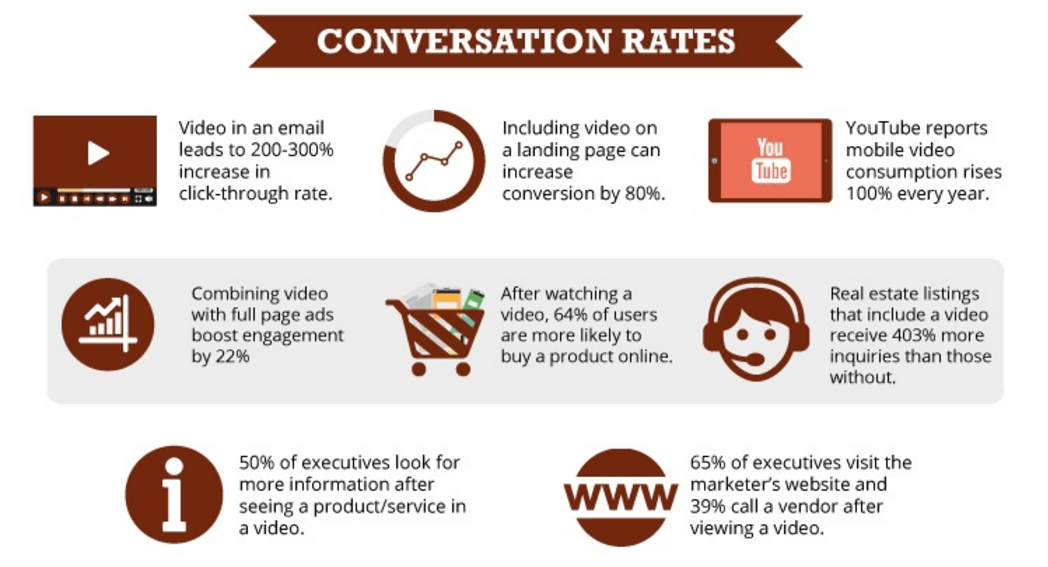
Videos Build Brand, Reduce Returns, and Help Build Trust
Video marketing statistics point out facts many ecommerce and lead-generation website owners fail to consider when tallying up the ROI of video marketing: videos help with brand-building, cut down on returns, and serve to increase the perceived level of trust in the brand.
The benefits of video marketing are more extensive than marketers often realize.
A cursory examination of Super Bowl commercials reveals how valuable video is to the largest brands, but the big game only comes once each year. By using video judiciously, both on your website and on other platforms where your brand has a presence, you can realize the Super Bowl effect (brand-building) 365 days per year.
Here are some pertinent video marketing statistics about YouTube video marketing, viral video marketing, social media video marketing, and more. All can help build your brand, lessen the return rate, and make your brand more trustworthy in the eyes of your audience.
- Videos drive consumer confidence and are viewed by 60 percent of shoppers who find them. Furthermore, 52 percent of shoppers say they are less likely to return a product when a video has been viewed prior to purchase (Steamboat Today).
- Where ecommerce sites use video merchandising fundamentals, the impact of the video is nearly doubled (Invodo Research).
- A three-year study by Cisco confirmed that consumers want to research products online before going to a brick and mortar store to make a purchase. Cisco advises retailers to embrace video both in-store and online (Internet Retailer).
- Videos show a positive effect on brand loyalty, garnering a 2.3 percent increase. Flash video (FLV) showed a 0.15 increase. Video ads boost purchase intent by 1.16 percent and draw more than 400 percent more conversions than Flash animation (DoubleClick).
- By 2011, 50 percent of manufacturing businesses had established a YouTube presence to enhance the brand and facilitate customer interaction (Industrial Marketing Today).
- The number of retailers using video on product pages rose 55 percent during 2009-2010. Of the 50 most successful retailers, 74 percent incorporated video for product information, 40 percent used video for category pages, and 38 percent for other types of informational videos.
- A 2010 study found that 33 percent of ecommerce stores prioritized the addition of video to their content mix (eMarketer).
- Over half of smartphone users surveyed (53 percent) say they feel more favorable towards websites and companies that offer video instructions about products or services (Google).
- Most senior-level executives (54 percent) say they share video content related to their work weekly with their teams and colleagues (TubularInsights).
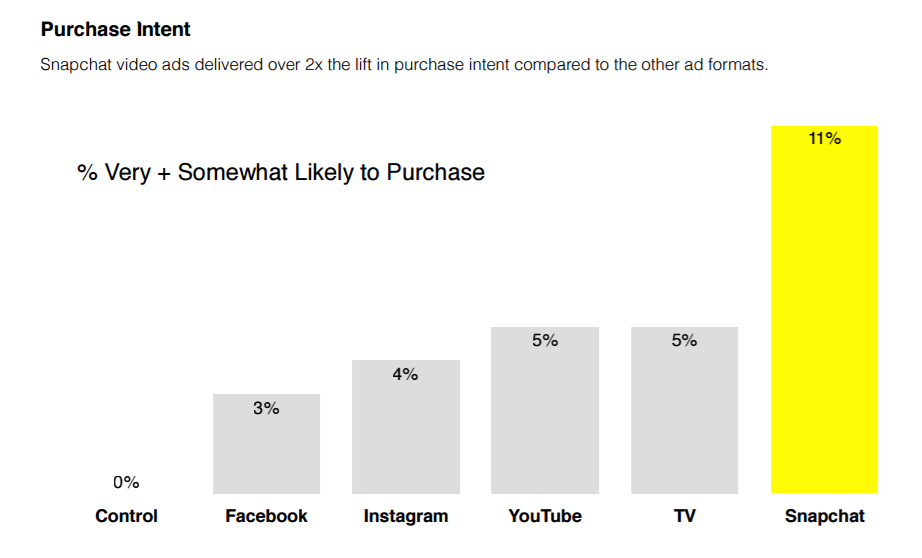
Search Engine Optimization and Video Marketing Go Hand-in-Hand – Google Loves Video
Here’s yet another area where video marketing online can deliver a handsome return on investment. Whether your marketing videos are hosted on Facebook, YouTube, your ecommerce website, or another platform, they can provide search engine optimization (SEO) benefits.
Here are three ways videos can impact SEO:
- When other websites link to the videos on your website, they are ‘voting’ for your content. Search engines use that as a signal that others find your content valuable.
- Videos draw visitors in and get them to spend more time on the host site. That cuts down on bounce rate and provides yet another ranking signal to search engines.
- Video metadata and descriptions provide additional ways for you to incorporate appropriate keywords. The more relative your video is to the searcher’s intent, the more likely your content will be found higher on the search engine results page (SERP).
The most valuable videos for SEO are those that support the intent of your website. If you sell camping gear, for instance, videos that portray some aspect of camping or highlight the benefits of one tent material over another will serve to anchor you in the niche. Don’t worry so much about creating that ‘viral video’ of cute kittens. You want content that’s relative and on topic.
Consider the following statistics, but don’t miss the point that video metadata and written descriptions must be optimized if you’re to realize maximum SEO value from your videos. The search engine doesn’t watch the video, it ‘reads’ the data you and your visitors provide.
Enjoying this article?
Subscribe to our newsletter, Good Question, to get insights like this sent straight to your inbox every week.
- Search engines love videos. One study found that seven out of ten of the top 100 results on a Google search include video. (Marketingweek).
- Video views grew by 123 percent after sitemaps were correctly configured on Discovery Channel (Discovery Digital Media).
- Properly optimized websites that employ video content are 53 times more likely to show on the first page of a Google search results (Forrester).
- Search engine optimization and video content are complimentary. Shoppers who first view a video end up with a larger average order value than those who don’t first view video before placing an order online (Internet Retailer).
- Videos help with multiple KPI’s – sales revenue, website visits per month, customer support demand, organic search results, time on site, etc. (Hubspot).
- The click-through rate for videos is higher than any other type of digital ad (Marketing Land).
- Emails with subject lines including a reference to “video” get 19 percent more opens and 65 percent better click-through rate (Invodo).
- The Facebook reach for videos is nearly double that of any other content there (Social Bakers).
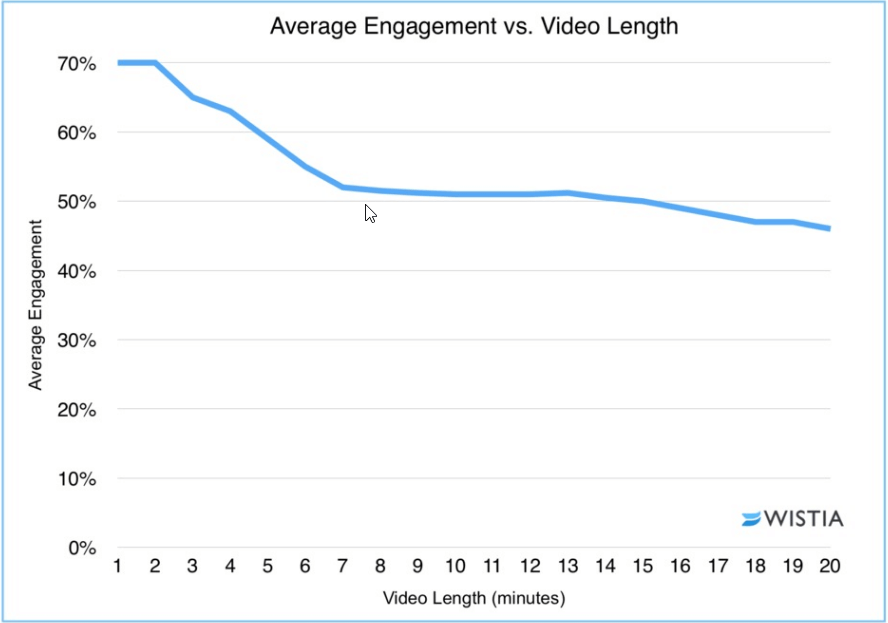
Videos Can Deliver Huge Engagement – They Are Massively Popular with the Online Audience
Keep the Wistia study in mind when you serve up videos to help with digital marketing. Shorter videos get draw better audience engagement. That helps with all the other benefits of video marketing we’ve mentioned: conversion optimization, brand-building, and SEO.
If your video is four minutes long, you are likely to get better results by splitting the video into a pair of two-minute presentations instead of presenting it as one four-minute video. Notice, though (referring back to the graph above), that engagement levels out again at about six minutes of video length and holds fairly level until about the 12-minute mark. Not every story can be told in two minutes or under. If you must run beyond that, the data says you’ve still an opportunity for steady engagement in that length range.
Engagement is one of the most exciting parameters we looked at in video marketing. The ramifications are immense. Content without engagement is like food without flavor… it may be consumed, but seldom enjoyed.
- Almost four of every five people online in the U.S. in 2015 watched videos at least once per month (Social Media Today).
- About half of all consumers will search for a video of a product online before visiting a store to see it in person (Google Insights).
- Product videos are an important part of consumer purchasing decisions. Mediapost recorded a 900 percent increase in retail video views after Black Friday (SDC Video).
- A study of retail site visitors found that those who view a video stay an average of two minutes longer on the site and are 64 percent more likely to purchase the item than those who don’t view the video (Internet Retailer).
- Over 60 percent of shoppers will view at least two minutes of video about a product they want to purchase, and 37 percent will view for three minutes or longer (MarketingCharts).
- A Living Direct study showed that videos not only boosted conversion, but increased the visitor’s time on site by nine percent (Digital Commerce 360).
- An Advanced Auto Parts study found that visitors who watch an instructional video on their ecommerce website tend to remain on the site twice as long and view double the number of pages as visitors who don’t view an instructional video at all.
- Video views on the Invodo network for 2011 were almost nine times higher (897 percent) over the prior year. Black Friday video views grew by almost four times year-to-year. (Website Magazine).
- Video views on retail and brand sites increased by more than 300 percent year-to-year in Q4 2011. Facebook was the chosen platform 46 percent of the time, with email accounting for 40 percent and Twitter capturing 14 percent of shares .
- Almost half (49.5 percent) of customers visited a local store to view a product before completing the purchase online (eMarketer).
- Mobile video viewing traffic rose 10 percent to make video viewing 50 percent of all mobile usage (ByteMobile).
- The number of U.S. mobile phone users with Smartphones rose by 38 percent year-to-year between February2010 and February 2011. Almost half of smartphone users during that same period said they used the phone to view video (E-Commerce Times).
- While shopping in-store, 65 percent of people use their smartphones to access the retailer’s website, 46 percent browse to a competitor’s website, and 26 percent check comparison shopping and review sites (eMarketer).
- The prediction of more mobile internet users than desktop and laptop users was correct. By 2011, more local searches were already being performed on mobile devices. (Microsoft Tag Mobile Marketing Report).
- Tablet use isn’t limited to the home; 40 percent of usage occurs elsewhere. 67 percent of respondents prefer a tablet for watching TV and 52 percent take a tablet with them to use while shopping (Online Publishing Association).
- Projections were for ecommerce sales to reach $119 billion by 2015. Actual was $154.8 billion (Mobi Thinking).
- Smartphone users who said they used the device to search for local retailers was 84 percent in 2011. 68 percent said they were searching to compare prices. (ROI Research Inc).
- A study looking at the preferences of affluent online shoppers found that 41 percent prefer video and search to any other digital advertising format (eMarketer).
- A Home Depot study found that 45 percent of in-store customers had also visited homedepot.com online (Retailgeek.com).
- The CEO of Best Buy reported that 60 percent of Best Buy U.S. store sales are influenced by the customer’s interactions on the company’s ecommerce website (Retailgeek.com).
- Of those who use their mobile devices for in-store shopping, 46 percent said they compared products and prices on competitors’ websites. Within two years, that number was up to over 80 percent (Forsee Results).
- Most smartphone users (66 percent) reported they had shopped at a retail store, but ended up making the purchase from a competitor’s ecommerce site. That is especially true in consumer electronics, but less so for shoes and clothing (Mediapost).
- Most smartphone users (83 percent) say their phone is the most important tool available for help with in-store shopping. 69 percent say they trust information found online more than advice from a store associate (Point of Sale News).
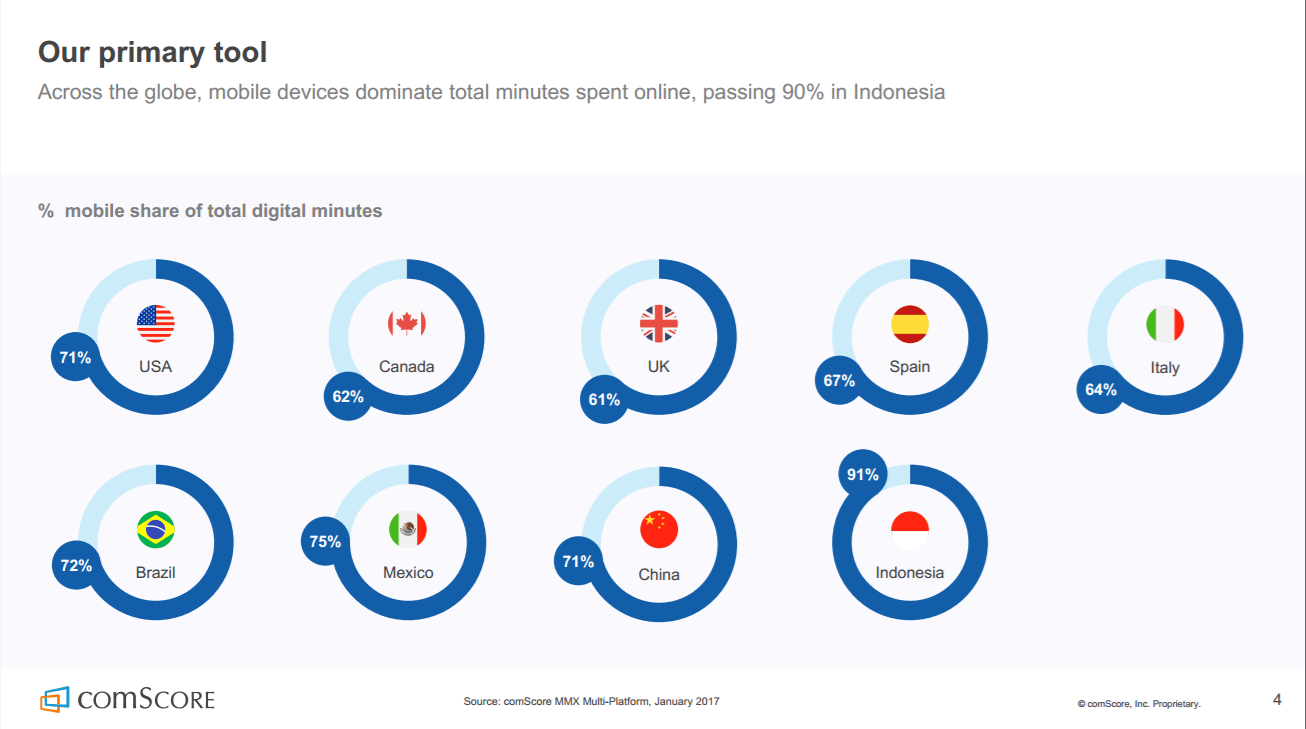
- Retail sales associates using an internet device are trusted as the best source of information (43 percent). Those who don’t have access to the internet are deemed most valuable by just 16 percent of shoppers (Point of Sale News).
- At the end of 2010, almost 25 million people had viewed videos online. That was up 40 percent over the prior year. 77 percent of viewers said their video-watching time had increased over that same period (eMarketer).
- By 2011, studies showed that 93 percent of those with smartphones were using them at home, not just at work, and almost half were using their phones to view videos. An incredible 90 percent of Google searches for products ended up leading to a store visit or purchase (Google Blog).
- The use of QR code scans rose by 181 percent in one quarter for smartphone users in the United States (eMarketer).
- One study showed (2011) that 56 percent of people surveyed reported seeing QR codes more frequently on products than anywhere else (eMarketer).
- QR code scanning increased by 130 percent over the course of 2010 alone (BeQRious).
- Of smartphone users surveyed in 2011, 79 percent reported using their phones to help with shopping. 74 percent said their phone had contributed to making a purchase either online or in-store (Google Blog).
- Most QR code scans are performed in order to get more information about the product. Accessing video content is the reason behind 25 percent of QR scans (Loyalty360).
- Obtaining more product information is the reason for 87 percent of QR code scans. Scans rose by 1200 percent in the last half of 2010 (Mobio Identity Systems).
- During an average month, 28 percent of those who own smartphones will use them to watch at least one video (Experian).
- When video is used in an introductory email campaign, email subscriber opt-outs can be reduced by 75 percent (Eloqua).
- The Vice President of Global Content for YouTube quoted Cisco’s prediction that video would take over as much as 90 percent of all traffic on the internet by 2019 (Forbes).
- A study comparing the differences between frequent and infrequent online shoppers found 46 percent of frequent shoppers prefer to ecommerce sites that offer video. 30 percent of infrequent shoppers said the same (Internet Retailer).
- A 2010 study found the number of people watching videos on any given day rose 32 percent over the previous year. Average viewing hours per month were at 14 hours, up 12 percent over 2009. There was an eight percent increase in the number of videos (201) each person streamed (Comscore).
- Most senior executives (59 percent) prefer video over reading text online, and 80 percent said their video viewing time was up over the previous year (Forbes Insight).
- Ecommerce site visits grew by 40 percent year-to-year during 2009-2010. Total online users grew by 17 percent, and 96 percent of all digital shoppers viewed videos online (Comscore).
- Video views soared from 14.8 billion to 33.2 billion during 2009, with 86.5 percent of online users watching at least one video during December of that year (Comscore).
- Instagram photos and videos are shared at the incredible rate of 95 million each day (Instagram).
- Almost half of online users (45 percent) watch an hour or more of videos on Facebook and/or YouTube each week (Hubspot).
- Facebook alone draws over 100 million hours of videos watched each day (TechCrunch).
- Most Twitter users (82 percent) watch Twitter-based videos (Twitter).
- The number of customers who say they WANT to see marketing videos is now over 43 percent (HubSpot).
- YouTube reaches (counting mobile only) more USA viewers 18 years and over than any cable television network – even during prime hours (Google)
- Almost a third of everyone online is a YouTube user. That amounts to over one billion people worldwide (YouTube).
- About three-fourths of all internet traffic bandwidth is taken up by video (Kleiner-Perkins, et al).
- Snapchat is serving up over ten billion videos to users each day (HubSpot)
- Facebook users prefer live videos to pre-recorded videos by a three to one margin (Facebook).
- Facebook organic engagement is highest (13.92 percent) on posts that include video (Locowise).
- Time on page increases by 2.6 times when video is present (Wistia).
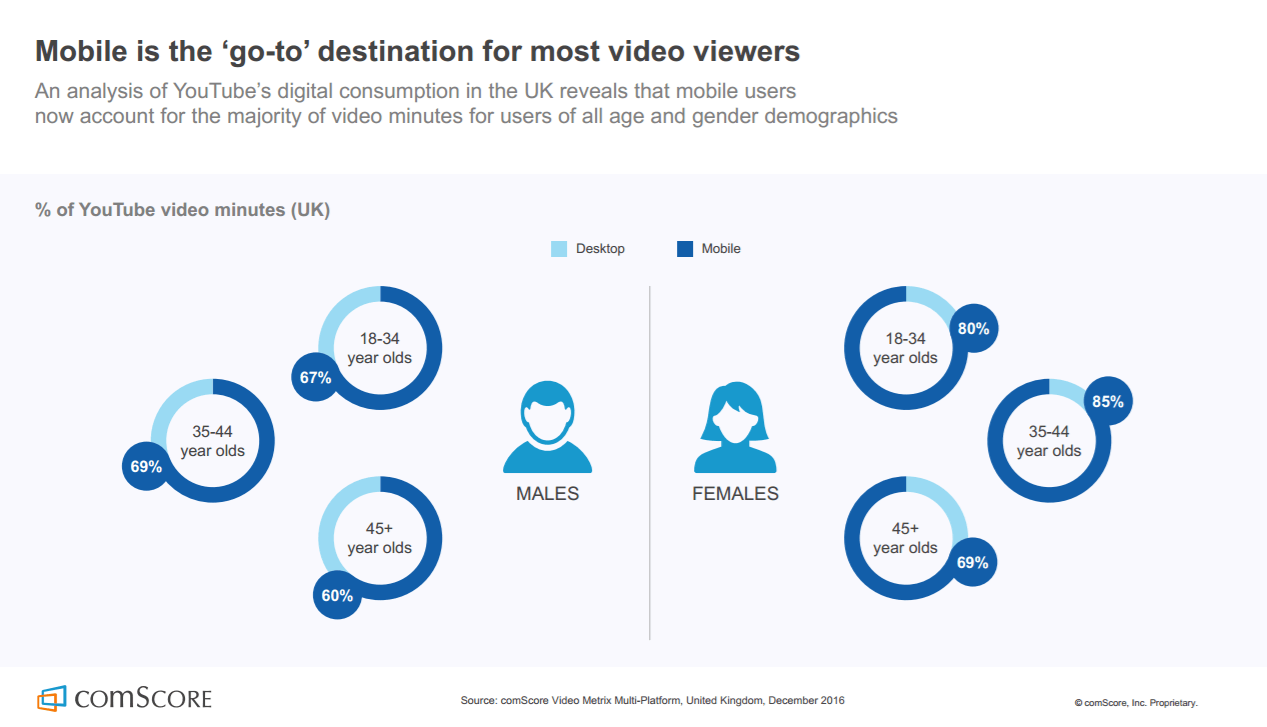
The Benefits of Video Marketing – Miscellaneous Impacts
Our research uncovered yet another way videos can be leveraged in ecommerce: customer service demands are diminished when customers are given a self-service video option for getting the information they need.
Couple that with Dr. James L. McQuivey’s (Forrester) almost unbelievable statement on the impact of video vs text (from his report on “How Video Will Take over the World”), and the research data showing the value of images to data retention to begin to feel the impact of what all of these studies and statistics are telling us.
- Demands on service calls were reduced by five percent in a Dell Computer study. Virgin Mobile expected a 14 percent reduction in service call volumes (The Australian).
- One minute of video delivers the same impact as 1.8 million words (Forrester).
- On average, people remember only ten percent of what they hear. Pair that information with an image, though, and the retention rate increases to 65 percent (BrainRules).
The 103rd Reason Why Your Video Marketing Strategy is Weak
You’re probably already using video in your marketing. By now, most ecommerce websites have stopped resisting the inevitable and have taken at least a cursory step towards embracing the obvious: Video marketing can deliver generous returns on investment.
Why aren’t you using video more, though? What is the barrier that keeps you and your marketing team from getting maximum leverage from the medium? And why aren’t you devoting more of your marketing budget to video?
Here’s what we’ve found. It’s a reason so simple and obvious many find it difficult to believe. If you’ll look closely, though, if you’ll consider your own strategic marketing plan through this lens, you may discover a psychological noose that’s choking your video marketing efforts.
Is this phenomenon impacting your video marketing strategy and results?
Have you ever listened to a recording of your own voice? Are you hypercritical when viewing photographs or videos taken of yourself?
Most of us are. Even movie stars grimace at their performance in films others love. For example, the critics raved over Megan Fox, but in an interview with Entertainment Weekly about her breakout performance in Transformers, Megan said, “”I’m terrible in it… the movie wasn’t bad, I just wasn’t proud about what I did.”
It’s the same way in business. We tend to be overly sensitive about out “own stuff.”
That’s why decision makers are prone to hesitate on developing and releasing video marketing assets. The videos aren’t ‘good enough.’ They never are. Consequently, few companies release anywhere near as many pieces of video content as they could.
We’re not advocating the production of sub-standard material, but we are saying that much of your hesitance is unwarranted.
Here’s a closing example.
We could film a quick video of me talking about the importance of video. It would be simple to produce a minute of commentary to highlight the assertion that video will extend visitor engagement time. We could even track results and eventually turn this report into a case study.
Why aren’t we doing that? It’s a great idea. It could be carried out with no more complicated equipment than a webcam. But that wouldn’t be professional enough… would it? One would need to go into a studio, spend thousands of dollars on the session, and eat up the best part of a day getting it just right.
Right?
Wrong.
Video marketing doesn’t mean Hollywood and major expenditures. Sometimes, the simplest path is the best path.
Try it and see.
Enjoying this article?
Subscribe to our newsletter, Good Question, to get insights like this sent straight to your inbox every week.